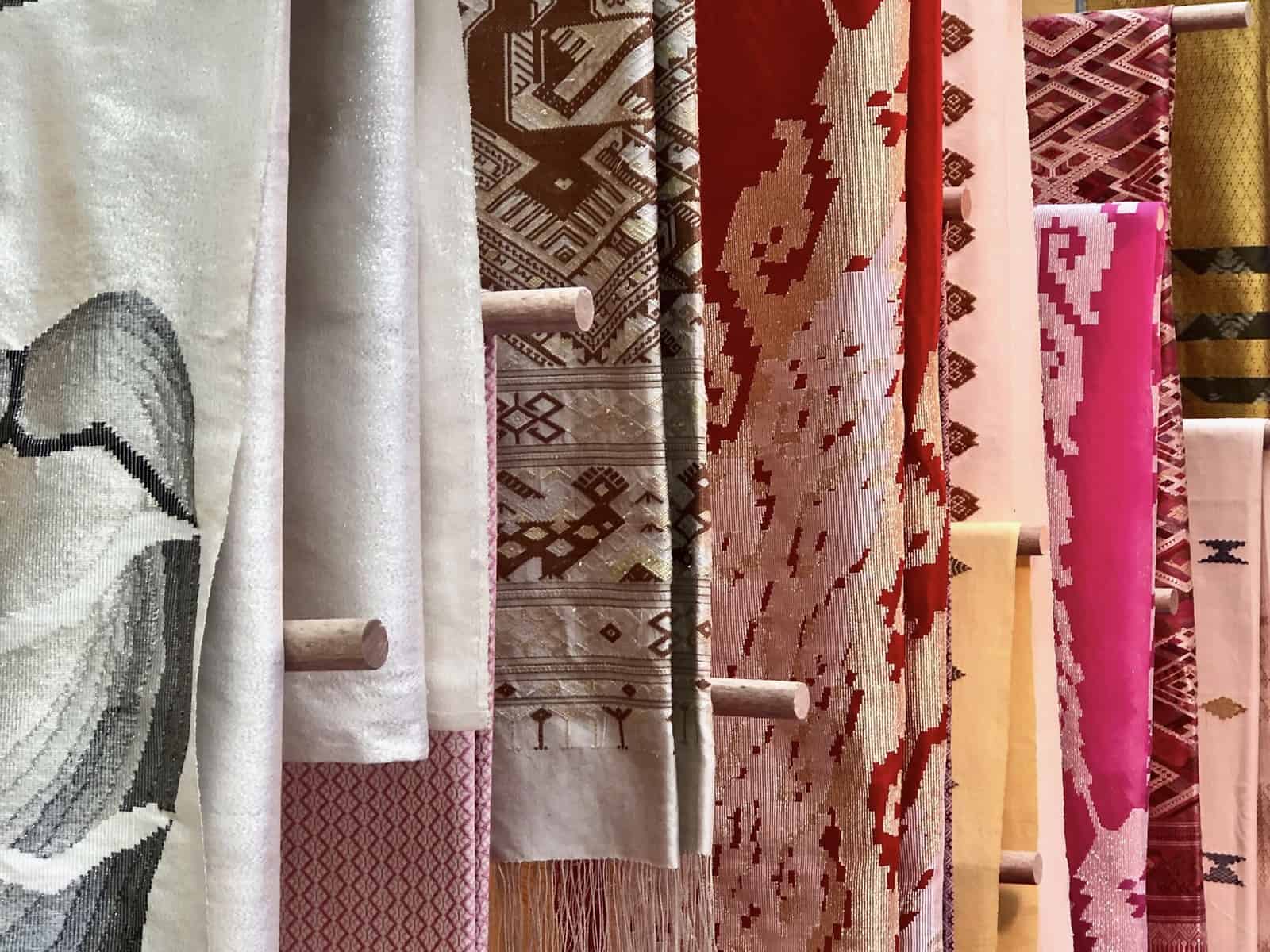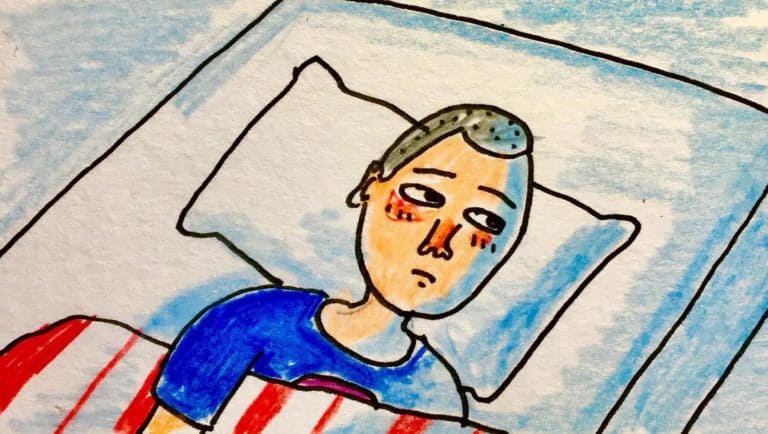 In June 2019, Sharon [Malaysian contemporary artist, Sharon Chin] spent three days in East Lombok, learning the weaving art. The village she visited, Lenek Lauk, is crowded houses, a mosque in use but half-finished, waves of paddy. When they aren’t out in the fields, the women of the village dye and weave. In recent years, with NGO assistance, they have run a cooperative to support their work – to share skills and labour; to buy thread in bulk; to find markets for the things they make. Locals prefer fabric coloured with synthetic dyes, because it is more affordable. “But foreigners like the ones made from natural dyes,” one of the Lenek Lauk women tells Sharon, savvily. “So we make those.”
In June 2019, Sharon [Malaysian contemporary artist, Sharon Chin] spent three days in East Lombok, learning the weaving art. The village she visited, Lenek Lauk, is crowded houses, a mosque in use but half-finished, waves of paddy. When they aren’t out in the fields, the women of the village dye and weave. In recent years, with NGO assistance, they have run a cooperative to support their work – to share skills and labour; to buy thread in bulk; to find markets for the things they make. Locals prefer fabric coloured with synthetic dyes, because it is more affordable. “But foreigners like the ones made from natural dyes,” one of the Lenek Lauk women tells Sharon, savvily. “So we make those.”

For dye, the weavers of Lenek Lauk collect mahogany, jackfruit wood, banten bark, mango leaves, ketapang leaves, indigo. Boiled and fixed, these dyes stain the thread in earthy hues: reds and browns and blues – often dramatically different from the materials they come from.

The thread is wound into balls.

The warp is prepped using a tool shaped like an upended table; the fabric’s eventual pattern is programmed here, on its upturned legs.

The warp is rolled up for the loom – an operation that takes at least four bodies; raw, steady strength; and sharp eyes, to make sure things are even, exact, that nothing is broken.

Only one person may operate the loom. But the art of weaving is not possible, alone.
Sharon had me tagging along, so I got to witness these processes. I sat and spun the andir, the tool used to wind balls of thread. This was the easiest task available. In a weaver’s hands, the andir is a whirligig. In mine, it start-stopped and quickly got stuck. The weavers giggled in Sasak and scolded me and helped me untangle my skein. I sat for two hours: spinning, spinning, spinning.

It never left me, the feeling that this was an incredible privilege. To sit, welcome in the women’s house.
Most places, weaving is considered a women’s art. Watching how the weavers of Lenek Lauk assemble their warps, seeing how procedural and algorithmic it is; how deft and practiced they are … Yeah. No wonder weaving gave us the loom and punch-card, the foundations of modern computing. These women, with their hand looms and their meticulously-programmed warps? Their art played an integral part in building our modern, rational world. Why did women wind up with a reputation as the “less logical sex”? How were they shackled to that vicious lie? There has been a theft of attribution. Men squat on the credit women deserve.
Soon after returning from Lombok, I posted on social media, saying versions of the stuff I’ve said above. Those were immediate sentiments. Obvious and easy ones. A feeling that wasn’t so easy to parse – one that is still difficult to express clearly, now – was my feeling of shame.
When Sharon and I were in Lombok, locals told us about the island’s close relationship to Malaysia. It isn’t a neutral relationship. Year after year, men from Lombok island cross the sea to the Peninsula. Sometimes they have papers; sometimes not. They cross the sea, to work. “Men from Java work in construction, but men from Lombok work farms and plantations,” Haji R told us. He was our driver, the days we were there. “I was in Johor, in the 1990s. I worked in a chicken factory.” Haji R did not have papers. He told us stories of being pulled over by police; of the need to pool money with his friends, to bribe officers; of how he squeezed savings from his meagre salary.
Later, we were told that all but two of the three-dozen-odd women in the Lenek Lauk weaving cooperative had husbands working in Malaysia. Some had not seen their husbands in years. Sometimes remittances would arrive; sometimes not. The weaving cooperative helped them be more financially independent.
Ibu K, maybe the oldest and most knowledgeable weaver there, told us about Lenek Lauk’s signature motif, Sari Menanti – “Sari waiting”.

“Sari waits for her husband, who has been away from home a long time,” Ibu K said. “She waits, and thinks, and weaves.” “Who is Sari?” Sharon asked. “A woman who lived long ago,” Ibu K replied.
Once colonies serving separate Western powers, the nation-states of Southeast Asia now leech off each other’s hinterlands – a circle-jerk of exploitation. Working-class Filipino women clean middle-class Malaysian homes. Malaysian soil literally underlies Singapore’s land-reclamation expansions. Indonesian sweat cements our cities, waters our cash-crops.
These are not equal exchanges. The metropoles take as much as they can, for as little as they can get away with. Last century’s colonialism is this year’s global economy.
Sharon came to Lombok on a commission from a Singaporean gallery, as part of the corporate-social-responsibility programme of a Malaysian bank. It felt uncomfortable to be welcomed into Lenek Lauk. Here we were, people from a place that had already taken their men and sons, asking to take still more.
One of the weavers, a short woman with a cheeky smile, kept asking me: “Sweets, where are my sweets?” Hand open, expectant.
“Sweets?”
“You come to visit me. But no gifts? You should give me sweets!” She was just teasing. Good-natured. But knowing.
I have to sit with my discomfort. I hope it doesn’t paralyze me.
I know and speak the right vocabularies. I could hand-wring at length about privilege, about my complicity in capitalist systems. I’d likely be lauded for my self-awareness. I hope I do not abstract the women I met into object lessons. Reduce them into Twitter-thread-worthy Rules For Standing In Solidarity With The Working Class.
What does true solidarity look like? I still don’t know.

The work Sharon created, in collaboration with the Lenek Lauk weaving cooperative, currently hangs in a Singapore National Museum atrium. Strips of woven cloth, each 2.5cm wide – a multitude of them, made by forty pairs of hands. “I asked 40 weavers if they could … weave negative space on the loom. What is not apparent is as important as what is obvious,” Sharon writes.
The work is called: Yang Tersurat dan Tersirat (Kolaborasi dengan Ibu-ibu Desa Lenek Lauk) – the seen and unseen; the said and unsaid.
[Editors’ Note: All photographs in this story, except the feature image, are by Sharon Chin. Full album here. This article was first published here. Sharon Chin’s work, and that of five other Southeast Asian contemporary artists, are part of Entwine: Maybank Women Eco-Weavers Travelling Exhibition at the National Museum of Singapore. The last day of the exhibition is 8 September 2019.]











